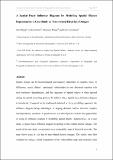Files in this item
A spatial fuzzy influence diagram for modelling spatial objects dependencies : a case study on tree-related electricity outages
Item metadata
| dc.contributor.author | Zhang, Zhe | |
| dc.contributor.author | Demšar, Urška | |
| dc.contributor.author | Wang, Shaowen | |
| dc.contributor.author | Virrantaus, Kirsi | |
| dc.date.accessioned | 2018-10-10T23:48:36Z | |
| dc.date.available | 2018-10-10T23:48:36Z | |
| dc.date.issued | 2018 | |
| dc.identifier | 251042590 | |
| dc.identifier | 15972cca-3d13-4bc9-8651-44b64a18f682 | |
| dc.identifier | 85031086026 | |
| dc.identifier | 000418759000007 | |
| dc.identifier.citation | Zhang , Z , Demšar , U , Wang , S & Virrantaus , K 2018 , ' A spatial fuzzy influence diagram for modelling spatial objects dependencies : a case study on tree-related electricity outages ' , International Journal of Geographical Information Science , vol. 32 , no. 2 , pp. 349-366 . https://doi.org/10.1080/13658816.2017.1385789 | en |
| dc.identifier.issn | 1365-8816 | |
| dc.identifier.other | ORCID: /0000-0001-7791-2807/work/48516837 | |
| dc.identifier.uri | https://hdl.handle.net/10023/16183 | |
| dc.description | We would like to acknowledge the National Emergency Supply Agency of Finland for funding this research. This material is also based in part upon work supported by the U.S. National Science Foundation under grant numbers [1047916 and 1443080]. The National Emergency Supply Agency of Finland funded the Alvar project. This article is the research outcome of the Alvar project. | en |
| dc.description.abstract | Spatial objects can be interconnected and mutually dependent in complex ways. In Geographical Information Science, spatial objects’ topological relationships are not discussed together with their attributes’ dependencies, and the vagueness of spatial objects is often ignored during the spatial modelling process. To address this, a spatial fuzzy influence diagram (SFID) is introduced. Compared to the traditional statistical or fuzzy modelling approach, the influence diagram brings advantages in helping decision-makers structure complex interdependency problems. A questionnaire was developed to evaluate the applicability of using an influence diagram in modelling spatial objects’ dependencies. As a case study, an SFID is applied to tree-related electric outages. The result of the case study is represented as a vulnerability map of electrical networks. The map shows areas at risk due to tree-related electric outages. The results were first validated by using a visual comparison of the vulnerability map and electricity fault data. In the second validation step, the percentage of fault data, which has received values in different vulnerability categories, was calculated. The results of the case study can be used to support the decision-making process of electrical network maintenance and planning. | |
| dc.format.extent | 2297298 | |
| dc.language.iso | eng | |
| dc.relation.ispartof | International Journal of Geographical Information Science | en |
| dc.subject | Influence diagram | en |
| dc.subject | Spatial fuzzy influence diagram | en |
| dc.subject | Critical infrastructure | en |
| dc.subject | Tree-related electric outages | en |
| dc.subject | Fuzzy logic | en |
| dc.subject | G Geography (General) | en |
| dc.subject | NDAS | en |
| dc.subject.lcc | G1 | en |
| dc.title | A spatial fuzzy influence diagram for modelling spatial objects dependencies : a case study on tree-related electricity outages | en |
| dc.type | Journal article | en |
| dc.contributor.institution | University of St Andrews. School of Geography & Sustainable Development | en |
| dc.contributor.institution | University of St Andrews. Bell-Edwards Geographic Data Institute | en |
| dc.identifier.doi | https://doi.org/10.1080/13658816.2017.1385789 | |
| dc.description.status | Peer reviewed | en |
| dc.date.embargoedUntil | 2018-10-11 | |
| dc.identifier.url | http://www.tandfonline.com/doi/full/10.1080/13658816.2017.1385789#supplemental-material-section | en |
This item appears in the following Collection(s)
Items in the St Andrews Research Repository are protected by copyright, with all rights reserved, unless otherwise indicated.

